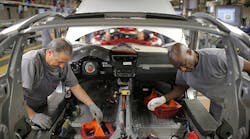My morning paper this week contained an unpleasant surprise. This passage, from a larger Washington Post article on the politics of the proposed Trans-Pacific Partnership trade agreement, caught my attention:
For decades, Democrats have pitched a manufacturing revival as the key to lifting millions more workers into the middle class. In recent months, though, some of the party’s leading economic thinkers have conceded that may not be true, because manufacturing employment is receding around the world as factories become more automated.
It’s a problematic few sentences.
Let’s start with the sweeping generalization in the first one. The Clinton administration certainly didn’t push a manufacturing revival. In fact, the training, economic, and trade policies it pushed in the 1990s reflected its view that America’s future rested in services and high-technology industries, and that manufacturing growth resided in countries like China and Mexico.
The Obama administration, conversely, has aggressively pushed the idea of a manufacturing revival … until recently.
To the president’s great credit, he put manufacturing front and center in the 2009 recovery package through the auto industry rescue, clean energy manufacturing incentives, and “Buy America” requirements for infrastructure. He followed that up with two impressive reports on advanced manufacturing; the establishment of a series of manufacturing innovation institutes, skills and training initiatives; an embrace of the maker movement and reshoring efforts; and strong attention to manufacturing in several of his State of the Union addresses. Perhaps more importantly, the president and his advisers professed a belief that manufacturing is the vital center of the American economy.
They could also read the polls showing enormous public support for Made in America.
What’s more, President Obama campaigned on the idea of a manufacturing revival, not once, but twice. In his first campaign, he promised to get tough on trade with China (although we now have a record trade deficit with China). He then promised to create 1 million new manufacturing jobs in his second term (our #AAMeter shows he’s falling way short of that goal). And his campaign commercials and personal appearances featured scores of American flags, hardhats, factory backdrops, and the words “Made in America.”
But now that he’s not running for office anymore and pushing a massive Pacific trade deal, his support has waned significantly.
So I differ on why the Obama administration’s advocacy for manufacturing and reshoring has ground to a halt. It begs the question: Does his administration believe that the best days for “Made in America” are already behind us, or was it all just a cynical political ploy?
Meanwhile, what is to be made of the automation argument laid out in the Post article? Is it an inevitable force that will swamp factory jobs as we know them?
Hardly. Automation and technology are nothing new for our manufacturing sector, or for the economy writ large.
There are banks without tellers. Stock trades without analysts and brokers. Walmart checkout lines without cashiers. Concerns over automation leads us to overinvest in activities (vocations like lobbying, massage therapy, laundry folding, or Chipotle burrito-making) that can’t be easily done by machines.
But scholars like Rob Atkinson and Michael Mandel have pointed out that increases in automation and productivity didn’t necessarily lead to widespread job losses in manufacturing in the 1970s, 1980s, or 1990s. Its fortunes were instead closely tied to business cycles. In the 2000s, the steep drop in manufacturing jobs was the product of twin recessions (2001 and 2008) bookending a surge in Chinese imports and output.
As long as the economic “pie” is increasing, automation doesn’t become the leading job killer. That means the real challenge concerning automation is twofold: How big is the pie becoming, (are the U.S. and global economies growing enough?) and how large a slice of that pie are we making?
The reality of manufacturing work will continue to change, but it will continue to need workers. Technology is increasingly embedded into products to make them smarter – but they still need to be manufactured by workers. Our problem is that America supplies a shrinking percentage of our own market, much less the global one.
It doesn’t have to be this way. We can produce more of our own goods – and more for the rest of the world – with the right public policies on trade, taxes, research, training, infrastructure, and energy.
Conversely, an America in which manufacturing jobs aren’t front and center for economic policy will grow into a scary place: declining tax revenues, reduced investment in research, career paths blocked for non-college attending young people, and a reliance on strategic competitors (China and Russia) to supply our own military.
If you think that’s a wildly dystopian view of the future, consider this: Following Superstorm Sandy in 2012, it took extra weeks to turn the lights back in some affected areas as we waited for a shipment of electrical transformers from Asia, because they are no longer made in America.
If Democrats really are giving up on a manufacturing jobs revival, I won’t blame Americans for turning the lights out on them.
Scott Paul is president of the Alliance for American Manufacturing.




